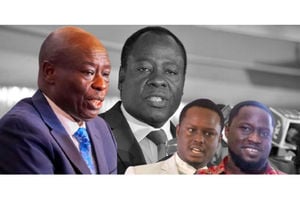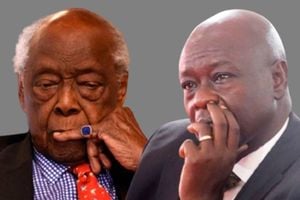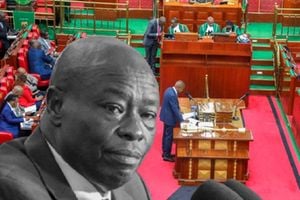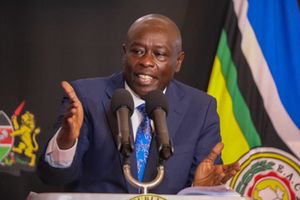Breaking News: Former Lugari MP Cyrus Jirongo dies in a road crash

Deputy President Rigathi Gachagua's impending impeachment sets stage for political upheaval. What's next for Kenya's power players?
It’s almost a foregone conclusion that Deputy President Rigathi Gachagua will lose his seat at the Senate impeachment trial at the end of this week. However, it could be a long-drawn-out exit if the DP’s battery of lawyers succeed in either stalling the Senate hearing or overturning the verdict in court.
The period leading to the National Assembly hearing on the impeachment motion filed by little-known Kibwezi West MP Mutuse Mwengi saw multiple High Court applications to halt proceedings thrown out. Many more have been filed since the Lower House voted overwhelmingly for impeachment and forwarded the matter to the Senate for final determination.
If the outcomes of the initial legal challenges are anything to go by, the courts have already indicated unwillingness to intervene on legislative business, but there are precedents where Senate decisions on impeachment of county governors have been overturned.
Unless it can be demonstrated that the impeachment process in the National Assembly was irredeemably flawed, chances are more than even that Gachagua will have to face the Senate, where numbers indicate that President William Ruto has a clearly upper hand over his estranged deputy.
If the impeachment sails through at the Senate, Ruto has a fortnight to nominate a replacement, but that will depend on how long it will take to exhaust legal challenges that would almost certainly go all the way up to the Supreme Court.
Gachagua has indicated that he is prepared to fight impeachment by available avenues, and to that end has assembled a large cast of lawyers led by experienced Senior Counsel Paul Muite to lead his case both in the Senate and the courts.
How long they can delay process, or if they can have the courts overturn the verdict remains to be seen. But whatever unfolds in the coming week, a major political upheaval is already taking place that will have major ramifications leading up to the 2027 General Election.
Ever since has assumed office as Deputy President after the 2022 polls, Gachagua has spent a lot of time and energy in largely futile attempts to full the yawning vacuum left in Mt Kenya leadership after the exit of President Uhuru Kenyatta.
He was not only trying to win over the few pockets in the populous regime that did not vote for Ruto and him on the Kenya Kwanza ticket, but was also out to strengthen his own political hand by taking control of the vast voter base in preparation for a future stab at the presidency.
The DP was not a very popular figure even though he had successfully led the vote hunt in the region, but ironically it took his falling-out with Ruto to earn him the support he had long craved. The big question now is what he will do with the massive support base once out of office.
It is obvious that he will want to throw his hat into the ring come the next elections, but there may be a complication in that if forced out of office by impeachment, he would automatically be barred from holding public office.
Although Gachagua publicly insists he will fight impeachment to the bitter end, there is quite discussion within his camp on all alternative strategy to forestall disqualification from holding public office and therefore being ineligible to run in 2027.
There are those who suggest that even if he vigorously defends himself before the Senate, he must take stock of the likely outcome, and if not guaranteed he can raise the numbers to defeat impeachment, resign just before a vote is taken.
Whatever happens, all sides are putting in strategies for 2027. Major political realignments are under way, with Gachagua looking towards an alliance with what remains of the Azimio coalition after opposition chief Raila Odinga decamped to President Ruto’s side.
Three million voters
The DP has engaged Wiper Party leader Kalonzo Musyoka, DAP-K leader Eugene Wamalwa and Jeremiah Kioni of the Uhuru faction of Jubilee towards a 2027 alliance. If he can claim command of the Mt Kenya vote basket, he brings to the table a bank of some seven million voters according to the 2022 registration.
That is about three million voters in the Mt Kenya heartland of Nyeri, Kiambu, Murang’a, Kirinyaga and Nyandarua counties; 1.3 million voters in the Mt Kenya East region of Meru, Tharaka-Nithi and Embu counties; and 260 voters in Laikipia County of the Rift Valley.
More than half of Nairobi, the 2.4 million registered voters in Nairobi County, and a similar proportion of the one million voters in Nakuru County of the Rift Valley can also be counted in the Mt Kenya vote basket.
To that impressive tally can be added another large number of Mt Kenya votes scattered elsewhere in the Rift Valley, Coast and other regions.
The importance of those numbers can be gauged by the fact that of the seven million votes won by Ruto in 2022, about half came from the Mt Kenya bloc, which now seems to have tilted to Gachagua. The region gave about 80 per cent of its vote to the Kenya Kwanza duo.
But will that vote walk away with Gachagua? Ruto strategists were aware of the risk as they moved to impeach the DP, and started planning way in advance on how to stem the exodus. One was by sending early signals that Gachagua’s replacement as DP, and thus Ruto’s presumed successor at State House, would also come from the region.
The ‘Nyahururu Declaration’ by Mt Kenya MPs which elevated Interior Cabinet Secretary Kithure Kindiki to regional political spokesman at Gachagua’s expense was part of the that strategy. At the same time came efforts to divide the regional vote by having the Mt Kenya East counties — Meru, Tharaka Nithi and Embu — assert their ‘independence’ from the dominant Kikuyu heartland.
Ruto strategists are also hopeful that bringing Raila to their side adds an impressive base, which will more than compensate for a Mt Kenya exodus. The veteran opposition chief came second in the 2022 presidential elections with over 6.9 million votes, just 230,000 less than Ruto, which was a difference of just 1.64 per cent.
Raila’s most solid support base is in the Nyanza region. At first glance the two million vote basket in the Siaya, Kisumu, Homa Bay and Migori counties might look puny in comparison to the Mt Kenya vote Gachagua aims to control, but Odinga appeals lies I the stark fact that his support is not limited to the single ethnic base.
A look at the color coded map of the 2022 election results shows that while Ruto’s Kenya Kwanza yellow commanded the Mt Kenya region and the his northern Rift Valley base, he was virtually surrounded by a large swathe Azimio blue that was dominant in the rest of Nyanza; parts of the western Kenya region nominally controlled by Prime Cabinet Secretary Musalia Mudavadi and National Assembly Speaker Moses Wetang’ula, the Lower Eastern region controlled by Kalonzo Musyoka, the southern Rift Valley, the coastal region and the North Eastern and Upper Eastern regions.
That is an impressive vote base that will now be critical to Ruto’s 2027 re-election prospects, but there is still a great deal of uncertainty on what it will take to secure Raila’s support. Even if the veteran opposition chief retires from active politics, especially if he clinches the African Union Commission chairmanship, ensuring his backing will not come cheap. Ruto is already committed to naming a deputy from Mt Kenya, most likely Kindiki, though some aspirants from the more populous Mt Kenya west such as Kirinyaga Governor Ann Waiguru, Laikipia East MP Mwangi Kiunjuri and Murang’a Governor Irungu Kang’ata are making their pitches.
Ruto is also stuck with Mudavadi as Prime CS, who is marking time while undoubtedly also interested making a State House bid at the appropriate time. The question now will be what Raila gets in return for supporting Ruto in 2027 when the two most important dockets are already occupied.
He got some four cabinet positions in the reconstituted government as reward for helping neutralize Gachagua and also counter the Gen Z protests that shook the Ruto government in June and July.
Designated successor
Those were mere tokens when weighed against the role he is played in helping Ruto survive, and the vital place he will occupy in the re-election strategy. It is obvious that come 2027, he will settle for nothing less than running mate and designated successor (If not for himself, for his ODM nominee) or for yet to be created post of Prime Minister, one with constitutional powers rather than just the elevated Cabinet position held by the Prime Cabinet Secretary. These are the political realignments to come that could upset the delicate governing coalition in the run-up to 2027.
Ruto has not given up on Mt Kenya yet, having moved against Gachagua early in hope that he will have time to repair the damage before the next polls. Already, his strategists are plotting an aggressive campaign that will see Ruto traverse the region laden with goodies after the impeachment is complete.
But Raila’s support base will also be expecting its own basketful of goodies in terms of development projects and appointments to key government jobs. There is also bound to be fair bit of pushing and shoving as realignments take shape.
Senior Nyanza figures such as former ICT cabinet secretary Eliud Owalo and Suba South MP Caroli Omondi, who had made themselves Ruto’s pointmen in Raila’s turf, will be reduced to irrelevance with the opposition chief himself in the bag.
In western Kenya, where Mudavadi and Wetang’ula are presumed to hold sway in Kakamega-Vihiga and Bungoma counties, respectively, Raila still holds a strong support base which is now keen to assert itself.
In Kakamega and Vihiga counties, Raila got 70 and 60 per cent of the vote, respectively, which might make his ODM party more useful to Ruto than Mudavadi’s ANC. The latter’s claim to western Kenya dominance and presidential hopeful is also diluted by the fact that Wetang’ula outperformed him in the vote hunt, winning Ruto 62 per cent of the county in Bungoma.
At the Coast, where the opposition was dominant in 2022, Ruto’s key men such as Senate Speaker Amason Kingi, Trade CS Salim Mvurya and acting UDA Secretary-General Hassan Omar might be looking over their shoulders as Raila’s men, such as Mining CS Hassan Joho and his successor as Mombasa Governor Abdulswamad Nassir, move to take their places in the new alignments.













